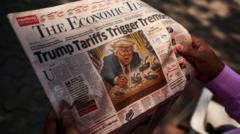Article text:
As the world faces a protectionist tide, India finds itself at a crossroads, where its trade policies may serve as both a shield and a hindrance to future growth. Currently ranked as the fifth-largest economy, India's economy is expanding rapidly, yet its reliance on a protectionist trade framework has limited its competitiveness on the global stage. With a share of global exports remaining below 2%, India's high tariffs and focus on self-sufficiency shine a light on the complexities of its trade approach.
In the midst of shifting trade dynamics, particularly following the recent actions of the United States, which included a 90-day tariff suspension, India's trade detachment may offer a buffer against disruptions that more export-reliant countries are facing. As Rajeswari Sengupta, an economics professor, points out, “India’s lower exposure could work in our favor. If other economies struggle, our strong growth—especially with our large domestic market—might present us as a more stable option.”
This notion, however, is tempered by the historical reluctance of India to embrace trade. Since the mid-20th century, circumstances have often compelled the country to adopt highly protective measures, particularly post-World War II and during the economic crises of the late 20th century. Experts like economist Arvind Panagariya highlight that while liberalization spurred notable export growth since the early 2000s, recent years have seen a rollback of these reforms, further entrenching India's protective stance.
The economic growth witnessed post-1991 reforms was promising. Exports surged and per capita income reached new heights. However, a push towards protectionism in the last decade has led to an increasingly isolating trade environment, crucially impacting manufacturing and export potential and creating a narrative of cronyism within certain Indian industries. This paradox arises as competing nations, particularly within the European Union, seek new partnerships amidst ongoing global uncertainty, leaving India at a critical juncture.
With the US's recent tariff strategies, forecasts suggest that India could witness a significant drop in exports. Economic analysts warn that a reduction of $7.76 billion from US markets could mark a substantial impact. Therefore, the call for India to enhance trade competitiveness and broaden its market base is more pressing than ever.
Economists advocate for a recalibration of India's trade policies. This includes reducing tariffs on various sectors like garments and textiles while proactively pursuing trade agreements with the EU, UK, and beyond. However, achieving these goals is contingent on critical domestic reforms to streamline processes and enhance overall trade efficacy.
As global trade conditions evolve, India stands at a pivotal moment, balancing short-term protectionism with the necessity of global trade integration. The choices made in coming months will significantly shape its economic trajectory and could either fortify its market position or further entrench it in isolation.
As the world faces a protectionist tide, India finds itself at a crossroads, where its trade policies may serve as both a shield and a hindrance to future growth. Currently ranked as the fifth-largest economy, India's economy is expanding rapidly, yet its reliance on a protectionist trade framework has limited its competitiveness on the global stage. With a share of global exports remaining below 2%, India's high tariffs and focus on self-sufficiency shine a light on the complexities of its trade approach.
In the midst of shifting trade dynamics, particularly following the recent actions of the United States, which included a 90-day tariff suspension, India's trade detachment may offer a buffer against disruptions that more export-reliant countries are facing. As Rajeswari Sengupta, an economics professor, points out, “India’s lower exposure could work in our favor. If other economies struggle, our strong growth—especially with our large domestic market—might present us as a more stable option.”
This notion, however, is tempered by the historical reluctance of India to embrace trade. Since the mid-20th century, circumstances have often compelled the country to adopt highly protective measures, particularly post-World War II and during the economic crises of the late 20th century. Experts like economist Arvind Panagariya highlight that while liberalization spurred notable export growth since the early 2000s, recent years have seen a rollback of these reforms, further entrenching India's protective stance.
The economic growth witnessed post-1991 reforms was promising. Exports surged and per capita income reached new heights. However, a push towards protectionism in the last decade has led to an increasingly isolating trade environment, crucially impacting manufacturing and export potential and creating a narrative of cronyism within certain Indian industries. This paradox arises as competing nations, particularly within the European Union, seek new partnerships amidst ongoing global uncertainty, leaving India at a critical juncture.
With the US's recent tariff strategies, forecasts suggest that India could witness a significant drop in exports. Economic analysts warn that a reduction of $7.76 billion from US markets could mark a substantial impact. Therefore, the call for India to enhance trade competitiveness and broaden its market base is more pressing than ever.
Economists advocate for a recalibration of India's trade policies. This includes reducing tariffs on various sectors like garments and textiles while proactively pursuing trade agreements with the EU, UK, and beyond. However, achieving these goals is contingent on critical domestic reforms to streamline processes and enhance overall trade efficacy.
As global trade conditions evolve, India stands at a pivotal moment, balancing short-term protectionism with the necessity of global trade integration. The choices made in coming months will significantly shape its economic trajectory and could either fortify its market position or further entrench it in isolation.



















